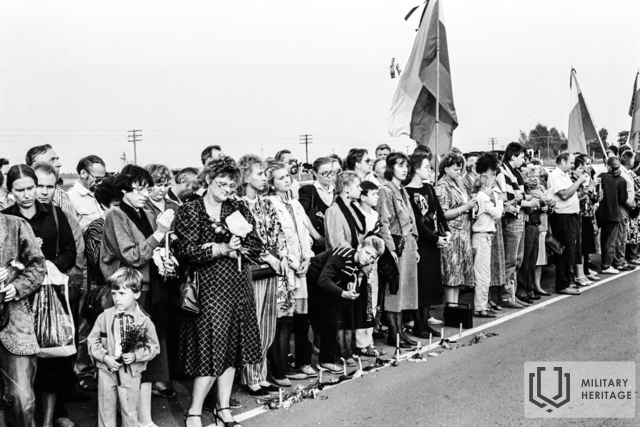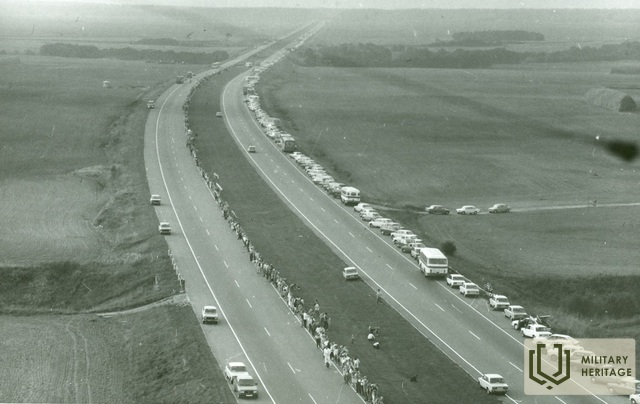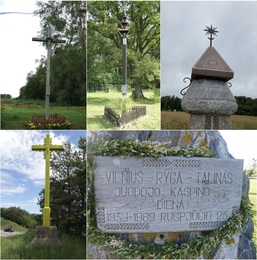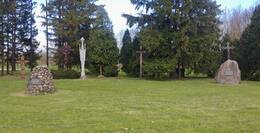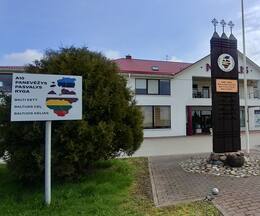The Baltic Way: for memory and study

The Baltic Way, which took place in 1989, continues to receive attention even more than 30 years after the event. New monuments are being built, commemorations and exhibitions are being organized. One of the initiatives is the inclusion of the documentary heritage of the Baltic Way in the UNESCO International Register of the Memory of the World.
The memory of the Baltic Way that took place in 1989 is cherished in a wide variety of forms: monuments erected along the route of this road in 1989 are preserved and restored, new monuments and other memorial signs are erected, museum expositions and exhibitions are created, commemorations are organized, etc. One example is the monument “The Path of Freedom” erected in Vilnius in 2010 at the initiative of the public and with funds donated by the public. As its initiators describe, “The Path of Freedom” is a sculpture dedicated to the twentieth anniversary of the restoration of the state of Lithuania and inviting all Lithuanian residents and patriots to continue the path of freedom and unity. It is an appeal not to forget the ideas of unity that helped Lithuania achieve freedom. The sculpture symbolizes a living chain of people that connected the three Baltic states that sought independence. The sculpture is made of more than 20,000 nominal bricks, its length is about 63 meters, and its height is about 3.5 meters.
In 2009, the documentary heritage related to the history and memory of the Baltic Way was included in the UNESCO Memory of the World International Register. The application for the nomination “The Baltic Way – Human Chain Linking Three States in Their Drive for Freedom” was prepared and documents were submitted by the Ministries of Culture of Lithuania, Latvia and Estonia, the National Archives and Libraries, the National Committees “Memory of the World” and the National UNESCO Commissions, the Institute of Lithuanian History, the Latvian National Front Museum and the Estonian Occupation Museum, and other institutions.
An information website – www.balticway.net – has been created to disseminate the documentary heritage of the Baltic Way.
In 2014, on the occasion of the 25th anniversary of the Baltic Way and as part of the implementation of the project “Baltic Way Stories”, another website was created – https://www.thebalticway.eu/en/. 920 stories from more than 20 countries around the world were collected. The project materials were transferred for safekeeping to the Central State Archives of Lithuania, the National History Museum of Latvia and the Estonian Occupation Museum.
- The Baltic Way, 2021, available online: https://www.thebalticway.eu/en/ .
- The Baltic Way – Human Chain Linking Three States in Their Drive for Freedom. 23 August 1989, 2008, online access: https://www.balticway.net/.
- Baltic Way. Freedom Road, 2010, available online: https://laisveskelias.lt/ .
- "The Baltic Way - a chain of people connecting three countries in the name of freedom", in: Lithuanian National Commission for UNESCO, 2012–2023, available online: https://unesco.lt/komunikacija-ir-informacija/unesco-programa-pasaulio-atmintis/unesco-tarptautinis-registras-pasaulio-atmintis/baltijos-kelias-zmoniu-grandine-sujungusi-tris-valstybes-laisves-vardan .
- "UNESCO International Register "Memory of the World"", in: Lithuanian National Commission for UNESCO, 2012–2023, available online: https://unesco.lt/komunikacija-ir-informacija/unesco-programa-pasaulio-atmintis/unesco-tarptautinis-registras-pasaulio-atmintis .
Related objects
Monuments along the Baltic Way section to commemorate the Baltic Way
Along the Baltic Road from Vilnius to Škilinpamūšis.
On August 23, 1989, to commemorate the 50th anniversary of the signing of the criminal Molotov-Ribbentrop Pact and its secret protocols, a human chain was formed by the Lithuanian Reorganization Movement, the Latvian People's Front, and the Estonian People's Front, connecting the capitals of the three Baltic states – Vilnius, Riga, and Tallinn. 2 million people joined hands in a chain about 650 km long. This chain, known as the Baltic Way, is one of the most striking and memorable events in the Soviet-occupied countries' quest for independence.
The Baltic Way was for some time listed in the Guinness Book of World Records as the longest human chain, and the documentary heritage testifying to this event was included in the UNESCO International Register “Memory of the World”. However, alongside these global and international forms of commemoration, there are also more modest, but no less eloquent, forms. In Lithuania, signs dedicated to its memory have been erected along the entire Baltic Way (the road ran along the Vilnius–Ukmergė–Panevėžys–Pasvalys section). In the Pasvalys district alone, there are 12 such signs of memory today – monuments made of various materials and in various forms. And there are several dozen of them along the entire section. The monuments were erected on the initiative of the Baltic Way participants themselves.
The Baltic Way in Lithuania began in Vilnius from the Gediminas Castle Tower. Today, this starting point is marked by a medallion embedded in the castle stone. And in the Šeškinė microdistrict of Vilnius (along the Ukmergė highway, at Ukmergės g. 24) there is a wooden monument in the form of a chapel pillar, which can be considered the symbolic beginning of the marked path. Its symbolic end is the sign of the connection of the Lithuanian and Latvian sections of the Baltic Way, located 200 km away near Saločiai.
Cross Valley to Commemorate the Baltic Way
The Cross Valley to Commemorate the Baltic Way memorial is located on the eastern outskirts of Pasvalys on the Via Baltica motorway (E67, A10).
On 23 August 1989, to commemorate the occasion of the 50th anniversary of the signing of the criminal Molotov-Ribbentrop Pact and its secret protocol, based on the initiative of the Lithuanian reform movement “Sąjūdis”, the Latvian People’s Front and the Estonian People’s Front, a live human chain linked the capitals of the three Baltic states – Vilnius, Riga and Tallinn. Holding hands, approximately two million people joined together in a living chain that was about 650 km long. This chain, known as the Baltic Way, is one of the most remarkable and memorable events on the road to independence of the countries occupied
by the Soviets.
To commemorate this event, memorial signs have been erected along the Baltic Way route (Vilnius-Ukmergė-Panevėžys- Pasvalys-Saločiai). The Cross Valley to Commemorate the Baltic Way is one of the monuments dedicated to this memorial route. The history of Cross Valley began on the eve of the Baltic Way when the residents of Pasvalys started using boulders to build the Altar of Freedom. On 23 August, the crosses were installed in the valley by the participants of the Baltic Way from Pasvalys, Akmene, Joniškis, Kretinga, Mosėdis, and Pakruojis. Later, crosses were erected to commemorate important events and
people of note, as well as crosses dedicated to the friendly Norwegian and Swedish people.
Memorial Sign of the Lithuanian and Latvian Section of the Baltic Way
The memorial sign is located north of Škilinpamūšis, on the Via Baltica motorway (E67, A10), next to the Latvian border, on the right side of the motorway.
On 23 August 1989, the three Baltic nations – Lithuanians, Latvians and Estonians – united in a historic event called the Baltic Way. On this day, to commemorate the 50th anniversary of the Molotov-Ribbentrop Pact and its secret protocol, a spectacular non-violent resistance event was organised. Approximately two million people joined hands to form a human chain that stretched for 650 kilometres from Vilnius through Riga to Tallinn. The Baltic Way has become not only a symbol of solidarity but also a powerful message to the world about the determination of the Baltic states to regain their independence.
One of the most important monuments commemorating the event is the memorial sign on the Lithuanian-Latvian border, which was erected in 2014 based on the initiative of the members of the Lithuanian reform movement “Sąjūdis” and the organisers of the 1989 Baltic Way.




